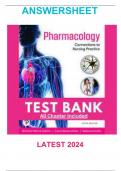ANSWERSHEET
LATEST 2024
,Test Bank for Pharmacology: Connections to Nursing Practice, 5th
Edition by Michael P. Adams, 9780137659166, Covering Chapters 1-75
| Includes Rationales
Adams and Urban, Pharmacology: Connections to Nursing Practice, 5th Edition
Test Bank
Chapter 1
Question 1
Type: MCMA
The nurse is teaching a pharmacology class to a group of student nurses. Which key events does the nurse include
in the history of pharmacology?
Note: Credit will be given only if all correct choices and no incorrect choices are selected.
ANSWERSHEET
Standard Text: Select all that apply.
1. Early researchers used themselves and animals as test subjects.
2. Pharmacologists began to synthesize drugs in the laboratory in the 20th century.
3. Modern pharmacology began in the mid-1600s.
4. The first drugs included morphine, cocaine, and penicillin.
5. The Dark Ages provided much useful information that we still use today.
Correct Answer: 1,2
Rationale 1: Early researchers did use themselves and animals as test subjects.
Rationale 2: Pharmacologists did begin to synthesize drugs in the laboratory in the 20th century.
Rationale 3: Modern pharmacology began in the 1800s, not 1600s.
Rationale 4: The first drugs included morphine and cocaine, but not penicillin.
Rationale 5: Little is known about pharmacology during the Dark Ages.
Global Rationale: The nurse would state that early researchers did use themselves and animals as test subjects;
pharmacologists did begin to synthesize drugs in the laboratory in the 20th century; and modern pharmacology
began in the 1800s, not 1600s. The first drugs included morphine and cocaine, but not penicillin. Little is known
about pharmacology during the Dark Ages.
Question 2
Type: MCSA
Although all areas of medicine, including pharmacology, have made great advances in the last century, the early
roots of pharmacology still apply for the nurse and other health professionals. What were the early roots of
2
,Test Bank for Pharmacology: Connections to Nursing Practice, 5th
Edition by Michael P. Adams, 9780137659166, Covering Chapters 1-75
| Includes Rationales
pharmacology?
1. Applying products to relieve human suffering
2. Creating new drugs as quickly as possible
ANSWERSHEET
3
, Test Bank for Pharmacology: Connections to Nursing Practice, 5th
Edition by Michael P. Adams, 9780137659166, Covering Chapters 1-75
| Includes Rationales
3. Finding medicinal alternatives to plants
4. Understanding how drugs take their effects
Correct Answer: 1
Rationale 1: The early root of pharmacology was to relieve human suffering.
Rationale 2: The early root of pharmacology was not to create new drugs quickly.
Rationale 3: Early pharmacology involved using plants to relieve symptoms of suffering.
Rationale 4: The early root of pharmacology was not to understand how drugs take their effects.
ANSWERSHEET
Global Rationale: The early root of pharmacology was to relieve human suffering, not to create new drugs
quickly or to understand how drugs take their effects. Early pharmacology did involve using plants to relieve
symptoms of suffering.
Question 3
Type: MCSA
Although many substances can be considered drugs, which drug definition is the most appropriate?
1. Any substance that is found in nature or that normally occurs in the body
2. Any substance that is synthesized and tested in the laboratory setting
3. Any substance that is taken to prevent, cure, or reduce symptoms of a medical condition
4. Any substance that can be isolated from natural substances in nature
Correct Answer: 3
Rationale 1: A drug is not a substance that is found in nature or that normally occurs in the human body.
Rationale 2: A drug is not only a substance that is synthesized and tested.
Rationale 3: A drug is considered to be any substance that is taken to prevent, cure, or reduce symptoms of a
medical condition.
Rationale 4: A drug is not only a substance isolated from natural substances.
Global Rationale: A drug is considered to be any substance that is taken to prevent, cure, or reduce symptoms of
a medical condition. A drug is not a substance that is found in nature or that normally occurs in the human body; it
is not any substance that is synthesized and tested in the laboratory setting, nor is it only a substance isolated from
4 natural substances. 4




